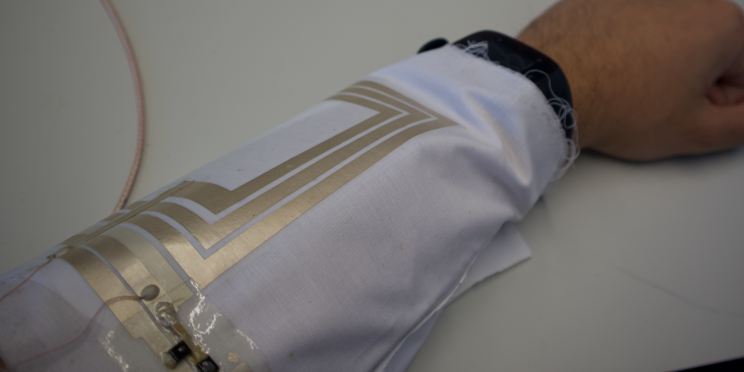Wireless-powered ‘smart bandage’ could provide drug-free wound care
28/06/2023

A new generation of wireless-powered, environmentally-friendly ‘smart bandages’ could help patients with non-healing wounds avoid infections, according to researchers from Interreg FCE funded project Smart-T.
The bandage could help improve the quality of life of people who live with chronic non-healing wounds, which currently require painful cleaning and treatment. Non-healing wounds can be a side effect of certain medications or health factors like diabetes, cancer or damaged blood vessels.
A team of researchers from the UK and France developed the first-of-its-kind bandage, which is embedded with light-emitting diodes (LEDs) to bathe wounds in sterilising ultraviolet light, preventing the growth of bacteria without the use of drugs like antibiotics.
UV light is already widely used to sterilise objects like surgical equipment and fresh food. Treating bacterial infections in non-healing wounds with UV light instead of drugs could help to slow the rise of dangerous new strains of antibiotic-resistant bacteria known as ‘superbugs’.
In a new paper published in the journal IEEE Transactions on Biomedical Circuits and Systems, the researchers outline how they built the smart bandage and demonstrated its antibacterial effectiveness.
They built a slim, flexible inductive coil which could be integrated into the fabric of the bandage. The coil uses a technique called magnetic-resonant wireless power transfer to provide power to the UV LEDs without the need for batteries.
Instead, the inductive coil receives its power over the air, transmitted from a second coil connected to the electrical mains. The LEDs can be powered indefinitely simply by keeping the transmitting and receiving coils close to one another until the antimicrobial treatment is complete.
In lab tests, the researchers exposed samples of a strain of gram-negative bacteria called Pseudoalteromonas sp. D41 to the UV light supplied by the smart bandage. Some forms of gram-negative bacteria can cause a range of serious infections in humans.
The tests showed that the smart bandage could slow and stop the growth of Pseudoalteromonas sp. D41 on the surfaces of slides, effectively eradicating the bacteria within six hours. The researchers suggest that the system could find use in medical settings to do the same for bacteria in patients’ chronic non-healing wounds.
Smart-T project has six project partners and researchers from two of partner organisations (University of Southampton, UK and at Infremer, France) contributed to the paper.
Professor Steve Beeby, RAEng Chair in Emerging Technologies at the University of Southampton (Smart-T lead partner) and co-author of the paper, said: “The use of ultraviolet light to kill viruses and bacteria is well known and this is the first work to integrate UVC emitting LEDs within a bandage and explore its efficacy. This approach could provide a significant benefit to the treatment of persistent wounds and is a major advance over typical smart bandages that attempt to monitor wound condition”.
Smart-T is a € 5,4M project (of which 3.7M was funded via ERDF). The project ran from April 2020-June 2023. Project partners include University of Southampton (lead partner), Ifremer - Centre de Bretagne, Université de Rouen Normandie, CNRS - Délégation régionale Normandie, INSA Institut National des Sciences Appliquées Rouen Normandie, SplashMaps Ltd.
Further information
Smart-T project website: SMARTT – Smart Textiles for Regional Industry and Smart Specialisation Sectors (interreg-smartt.org)
The smart bandage paper, titled 'Wirelessly Powered Drug-free and Anti-infective Smart Bandage for Chronic Wound Care’, is published in IEEE Transactions on Biomedical Circuits and Systems.
